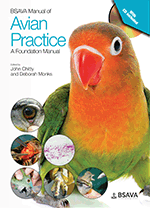
Full text loading...

This chapter provides comprehensive guidance on the basic techniques veterinary practitioners will routinely employ in avian practice. The chapter covers techniques for various injection methods, oral medication, nasal flush, nail trimming, beak trimming, various feather techniques, ring removal, microchip placement and euthanasia. Quick reference guide: Euthanasia of birds. The chapter also includes 15 video clips.
Basic techniques, Page 1 of 1
< Previous page | Next page > /docserver/preview/fulltext/10.22233/9781910443323/9781910443323.15-1.gif

Full text loading...





















Supplements
Beak trimming in a Blue and Gold Macaw
Intravenous catheter inserted into the tarsal vein of a macaw
Intraosseous catheterization in a Cockatiel
Intraosseous catheterization in a Grey Parrot
Intravenous injection in the tarsal vein of a macaw
Jugular blood sample taken from a non-anaesthetized Grey Parrot
Jugular blood sample taken from an anaesthetized Harris’ Hawk
Microchipping a non-anaesthetized Grey Parrot
Microchipping an anaesthetized Black-headed Caique
Nail trimming in an anaesthetized Black-headed Caique
Nasal flushing performed on an Amazon parrot
Oral medication administered to a tame Amazon parrot
Removal of a steel ring from a Canary
Subcutaneous injection into the precrural fold of a lovebird
Wing trimming in a Double Yellow-headed Amazon